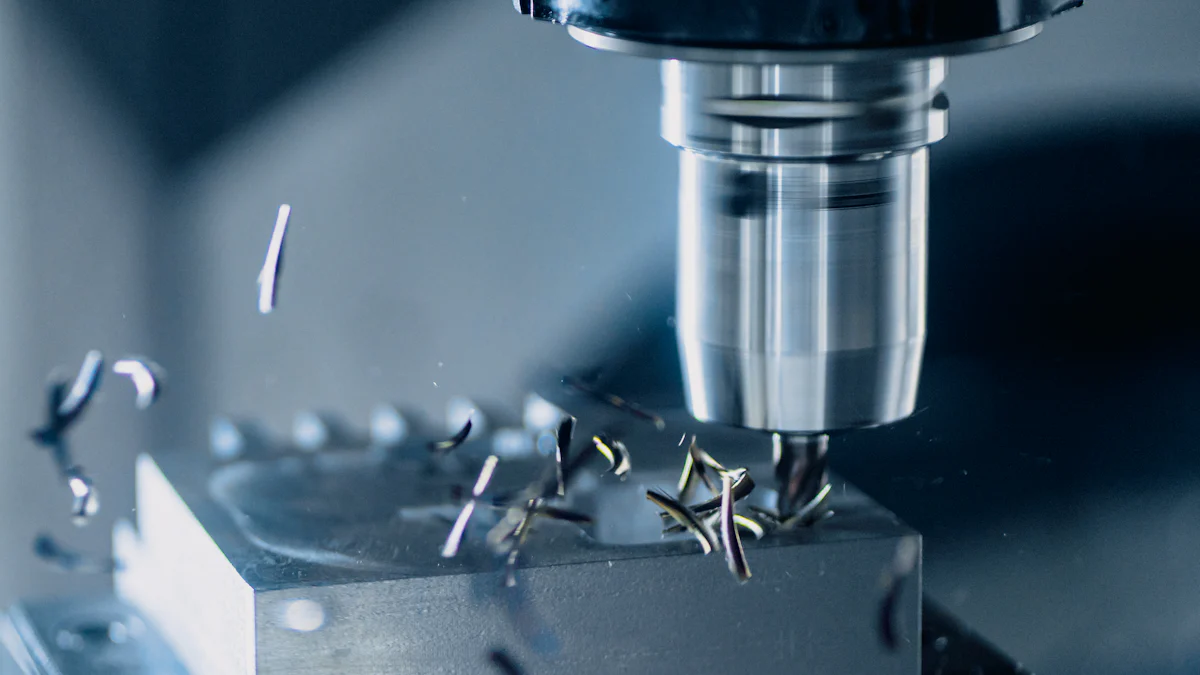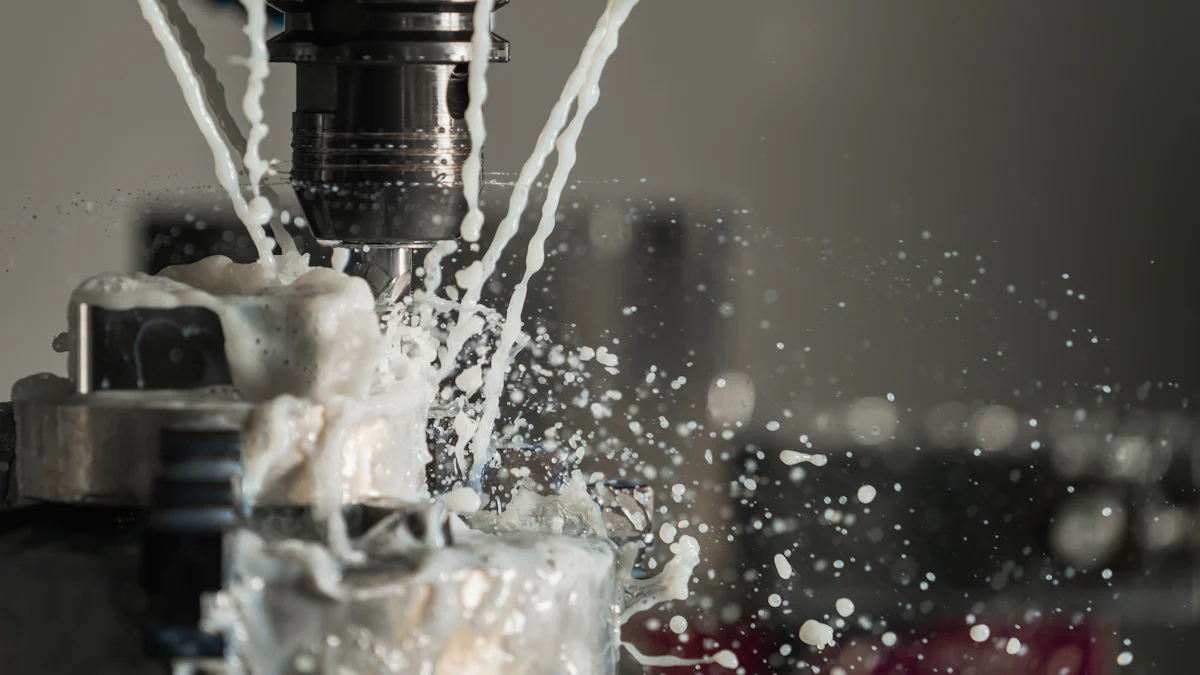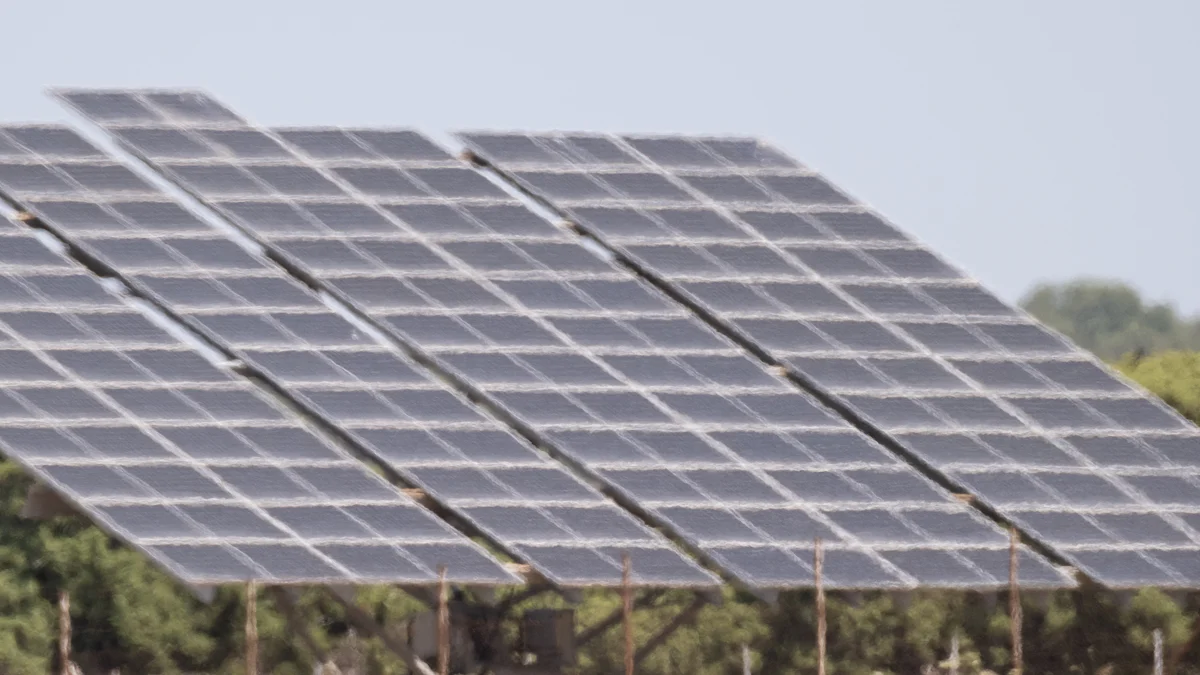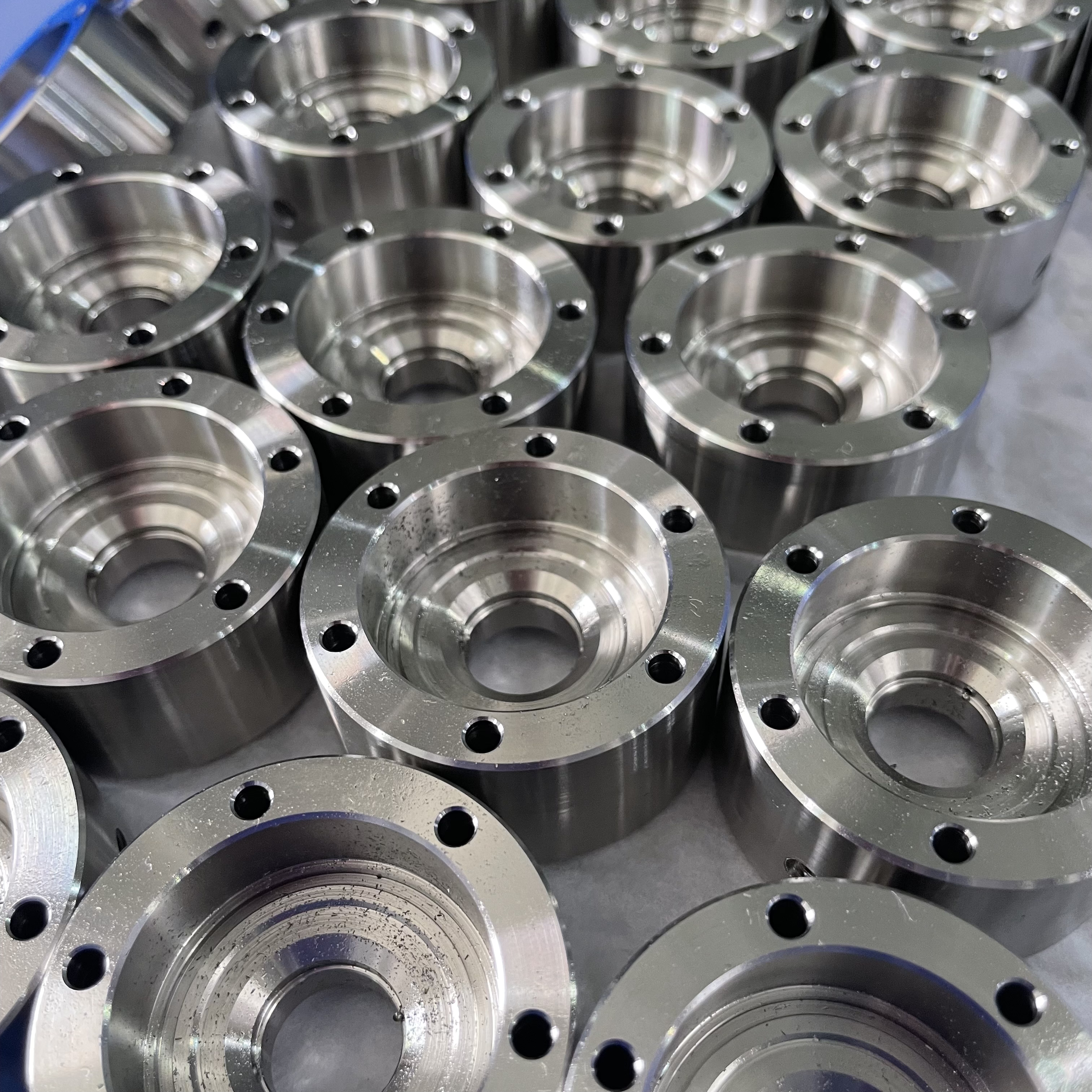How CNC Technology Reduces the Carbon Footprint of Manufacturing

CNC Machining transforms manufacturing by promoting sustainability and reducing the carbon footprint of production processes. You benefit from its precision, which minimizes material waste and ensures efficient energy use. Advanced control systems and sensors optimize energy consumption without compromising quality. These machines follow exact specifications, reducing errors and unnecessary resource usage. Modern CNC systems even feature energy-saving modes, such as automatic shut-off when idle. By adopting CNC technology, you contribute to cleaner production practices and a more sustainable future.
Key Takeaways
CNC machines waste less material by cutting only what is needed.
Energy-saving CNC machines use less power and create fewer emissions.
Making products as needed with CNC reduces storage and shipping.
Using renewable energy with CNC machines lowers the use of fossil fuels.
CNC technology improves work efficiency and shows your brand cares for the environment.
Understanding CNC Machining and Its Role in Sustainability
What is CNC Machining?
Overview of CNC machining and its automated processes
CNC machining, or Computer Numerical Control machining, uses pre-programmed software to control machinery and tools. This technology automates manufacturing processes, enabling you to produce parts with exceptional precision. Unlike traditional methods, CNC machining eliminates the need for manual intervention during cutting, drilling, or shaping. Machines follow exact digital designs, ensuring consistent quality and reducing errors.
Automation in CNC machining also allows you to scale production efficiently. Whether you need a single prototype or mass production, CNC systems adapt seamlessly. This flexibility makes it a cornerstone of modern manufacturing.
Key features that make CNC machining energy-efficient
CNC machining incorporates features that optimize energy use. Advanced programming ensures machines operate only when necessary, reducing idle time. Many CNC systems include energy-saving modes, such as automatic shut-off when not in use. These features lower electricity consumption without compromising performance.
Additionally, CNC machines achieve high precision, which minimizes material waste. By cutting only what is needed, you avoid excessive energy use associated with rework or overproduction. Some systems even integrate renewable energy sources, such as solar or wind power, further enhancing energy efficiency.
The Role of CNC Manufacturing in Modern Industries
Precision and reduced waste in production
CNC manufacturing excels in precision, which directly impacts waste reduction. Traditional methods often generate significant scrap due to inefficient material removal. CNC systems, however, use advanced programming to cut materials with exact accuracy. This reduces waste and ensures optimal resource utilization.
CNC machining stands out as a sustainable solution in modern manufacturing due to its precision, efficiency, and eco-friendly practices. Utilizing advanced programming and automation, CNC machines achieve precise material removal, significantly reducing waste and resource consumption compared to traditional methods.
By adopting CNC manufacturing, you contribute to sustainable manufacturing practices that prioritize efficiency and environmental responsibility.
Applications across industries for sustainable manufacturing
CNC manufacturing supports sustainable manufacturing across various industries. In aerospace, it produces lightweight components that reduce fuel consumption. In the automotive sector, it enables the creation of energy-efficient parts. Even in consumer goods, CNC machining facilitates the use of recyclable materials.
This technology also aligns with key principles of sustainability, such as energy efficiency, waste reduction, and the use of renewable energy. By integrating CNC systems, industries can achieve cleaner operations with less environmental impact. You can also explore sustainable materials, such as biodegradable or recyclable options, to further enhance eco-friendly practices.
Environmental Challenges Addressed by CNC Manufacturing
Reducing Material Waste
Inefficiencies in traditional manufacturing methods
Traditional manufacturing methods often result in significant resource consumption and waste. Inefficient material removal processes generate excessive scrap, while overproduction leads to unused inventory. These practices not only waste raw materials but also increase energy demands. Additionally, the use of coolants and lubricants in machining creates hazardous waste, posing risks to the environment and human health.
CNC machining's role in optimizing material usage
CNC machining addresses these inefficiencies by maximizing material efficiency. Using CAD software, you can program machines to follow exact specifications, ensuring precise cuts that align with design requirements. This reduces mistakes and minimizes material waste. CNC systems also support lean manufacturing practices, which optimize processes to lower material and energy consumption. By extending tool lifespan and reusing byproducts, CNC machining promotes waste reduction and eco-friendly practices.
Lowering Carbon Emissions
Energy-efficient machines and their impact
Energy-efficient machines in CNC manufacturing significantly reduce power consumption. These machines operate with advanced programming that minimizes idle time and optimizes energy use. High-efficiency CNC systems perform tasks faster while consuming less energy, which lowers carbon emissions. By adopting such systems, you can achieve sustainability goals and reduce the environmental impact of your operations.
Minimizing emissions through localized production
CNC technology enables localized production, which reduces the need for long-distance shipping. By producing parts closer to their final destination, you can cut down on transportation-related emissions. Additionally, CNC systems streamline workflows and improve accuracy, further enhancing energy efficiency. This approach aligns with sustainability standards and appeals to environmentally conscious clients.
Tackling Energy Consumption
High energy demands of traditional manufacturing
Traditional manufacturing relies heavily on fossil fuels, leading to high energy consumption and a substantial carbon footprint. Operating tools and equipment requires significant electricity, which contributes to climate change. These energy demands highlight the need for more sustainable solutions.
CNC integration with renewable energy sources
CNC machining integrates seamlessly with renewable energy sources like solar and wind power. This reduces reliance on non-renewable energy and lowers the carbon footprint of manufacturing operations. By adopting renewable energy, you align with global eco-conscious practices and enhance the sustainability of your production processes.
How CNC Technology Achieves Lower Carbon Emissions

Material Efficiency in CNC Machining
Precision cutting and reduced scrap material
CNC machining enhances material efficiency by providing precise control over material removal. This precision minimizes waste, as machines cut only what is necessary to meet design specifications. Advanced CAM software further optimizes material usage by efficiently nesting parts on raw materials, reducing scrap. You can also use recycled metals and plastics in CNC processes, aligning with the circular economy. This approach promotes reusing and repurposing materials, which reduces environmental impact. Additionally, CNC machining supports on-demand production, helping you avoid overproduction and excess inventory.
Lean manufacturing principles in CNC processes
Lean manufacturing principles integrate seamlessly with CNC machining to reduce waste and energy consumption. Producing parts in response to demand prevents unnecessary material usage. Continuous improvement practices encourage you to regularly evaluate and refine processes, identifying areas for further efficiency. These principles ensure that CNC machining not only meets production goals but also aligns with sustainability objectives.
Energy-Efficient Machines in CNC Manufacturing
Features that optimize energy use
Energy-efficient machinery in CNC manufacturing incorporates features that significantly reduce power consumption. For example, optimizing spindle speed and cutting depth ensures tasks are completed efficiently without wasting energy. Advanced software creates efficient tool paths, lowering electricity usage. Reducing idle time and maintaining consistent load variability also contribute to energy efficiency. Upgrading to energy-efficient motors or retrofitting machines with variable frequency drives can further enhance performance while minimizing electricity consumption.
Feature | Impact on Energy Efficiency |
|---|---|
Spindle Speed | Optimizing for specific tasks can improve efficiency. |
Feed Rate | Higher rates may increase power demand but reduce machining time. |
Cutting Depth | Optimizing can reduce energy usage while maintaining productivity. |
Tool Path | Efficient paths lower electricity consumption. |
Idle Time | Reducing idle time lowers overall energy usage. |
Energy-Efficient Motors | Upgrading reduces electricity consumption without performance loss. |
Renewable energy-powered CNC systems
CNC machining integrates with renewable energy sources to further reduce its carbon footprint. Many manufacturers now power CNC systems using solar, wind, or hydropower. This shift supports sustainability goals while maintaining production efficiency. CNC technology also plays a critical role in creating components for renewable energy systems. For instance, it produces wind turbine blades, solar panel frames, and hydropower components with high precision, ensuring durability and optimal performance.
Waste Reduction and Recycling
Cleaner production processes with CNC
CNC machining promotes cleaner production by reducing waste and optimizing energy usage. Techniques like nesting and part optimization ensure minimal material waste during production. By using energy-efficient machines, you conserve natural resources and lower carbon emissions. These eco-friendly practices not only benefit the environment but also result in significant cost savings.
Reuse of byproducts in CNC operations
CNC operations often generate byproducts that can be reused to minimize waste. For example, scrap materials can be collected, processed, and reintroduced into the production cycle through closed-loop systems. This reduces the need for new raw materials and lowers production costs. Reusing byproducts also aligns with sustainability efforts, helping you achieve more efficient and environmentally friendly operations.
Strategy | Description |
|---|---|
Reused Materials | Opting for reused materials when possible helps reduce waste. |
Closed-Loop Systems | Collecting, processing, and reintroducing waste materials into the production cycle minimizes waste. |
Cost Reduction | Using scrap material reduces the amount of new materials needed, leading to cost savings. |
Transportation and Logistics Benefits
On-demand production reducing shipping needs
CNC technology enables on-demand production, which transforms how you manage logistics. Instead of producing large quantities of items in advance, you can manufacture parts or products only when needed. This eliminates the need for extensive storage facilities and reduces associated costs like insurance and inventory management. Traditional manufacturing often requires complex logistics systems to handle pre-manufactured goods, which increases expenses and environmental impact.
By adopting on-demand production, you simplify your supply chain. You no longer need to transport large batches of products to warehouses or distribution centers. This approach minimizes shipping requirements, which lowers fuel consumption and reduces carbon emissions. Additionally, on-demand production allows you to respond quickly to customer needs, ensuring efficient and sustainable operations.
Tip: On-demand production not only reduces logistics costs but also aligns with eco-friendly practices by cutting down on unnecessary transportation.
Digital file transfers minimizing physical transportation
Digital file transfers in CNC machining further enhance sustainability by reducing the need for physical transportation. Instead of shipping prototypes or designs, you can send electronic files directly to manufacturing facilities. This process streamlines production and eliminates the emissions associated with transporting physical items.
Digital file transfers allow you to transmit designs electronically, saving time and resources.
By reducing transportation, you contribute to a lower carbon footprint and support sustainable manufacturing practices.
This shift reflects a commitment to environmentally conscious operations, which benefits both your business and the planet.
The ability to share designs digitally also fosters collaboration across global teams. You can work with partners or clients in different locations without relying on traditional shipping methods. This not only saves costs but also accelerates production timelines, making your operations more efficient and sustainable.
Note: Embracing digital file transfers in CNC machining is a simple yet impactful way to reduce emissions and promote green manufacturing.
Innovations and Future Trends in CNC for Sustainability

Advancements in Energy-Efficient Machines
Development of carbon-neutral CNC systems
Energy-efficient CNC machines are transforming manufacturing by reducing operational costs and environmental impact. These machines use smaller motors and advanced drive electronics, which consume less power. Recent innovations include lighter components and rigid structural designs that further enhance energy efficiency. For example, machines like DATRON’s M8Cube and MLCube incorporate low-torque spindles and energy-efficient electronics, making them ideal for sustainable production. By adopting these advancements, you can reduce your carbon footprint and align with global sustainability goals.
AI-driven optimizations for energy savings
Artificial intelligence (AI) is revolutionizing CNC machining by improving energy efficiency. AI predicts tool wear, ensuring precise machining and reducing waste. It also optimizes tool paths, which minimizes material usage and enhances production efficiency. Advanced algorithms analyze past operations to identify the best settings, leading to higher-quality outputs. Real-time adjustments powered by AI further improve sustainability by conserving resources and lowering energy consumption. These technologies enable you to achieve efficient and eco-friendly manufacturing processes.
Sustainable Materials in CNC Machining
Use of recyclable and biodegradable materials
CNC machining supports the use of sustainable materials like recycled metals and biodegradable plastics. These materials reduce environmental impact and promote recycling metal scraps. By incorporating such materials into your production, you contribute to a circular economy. Recycling strategies also lower raw material costs, making your operations more sustainable and cost-effective.
CNC compatibility with lightweight materials
CNC technology excels in working with lightweight and recyclable materials. It determines optimal cutting patterns, maximizing the number of parts produced from a single material. This reduces waste and supports sustainability. Additionally, CNC machining enables the creation of components that can be disassembled, repaired, or recycled. This ensures that materials can be reused effectively at the end of their lifecycle, further enhancing eco-friendly practices.
Smart Manufacturing and IoT Integration
Real-time monitoring for resource optimization
The Internet of Things (IoT) is transforming CNC manufacturing by optimizing resource usage. IoT-enabled systems monitor operations in real time, ensuring cuts and molds meet precise specifications. This reduces waste and improves energy efficiency. IoT also adjusts operation schedules based on demand, lowering energy consumption. By integrating IoT, you can maximize raw material use and extend tool lifespan, reducing costs and emissions.
Predictive maintenance to reduce waste and downtime
Predictive maintenance enhances CNC system efficiency by identifying issues early. It prevents defects by addressing changes in machine conditions before they cause errors. Maintenance schedules are optimized to reduce unnecessary downtime and resource use. Real-time data enables you to improve production processes, ensuring efficient resource utilization. This approach extends equipment lifespan, reduces waste, and minimizes the need for replacements, making your operations more sustainable.
Tip: Embracing predictive maintenance and IoT integration can significantly enhance your CNC system's efficiency while supporting sustainability goals.
Future of CNC Manufacturing
Enhanced automation for sustainability
Automation in CNC manufacturing is paving the way for more sustainable production practices. By integrating advanced technologies like AI and machine learning, you can optimize machining processes and reduce material waste. These systems analyze operations in real time, ensuring precise cuts and efficient resource use. This approach not only minimizes waste but also extends the lifespan of tools, lowering production costs.
Automation also enhances energy efficiency. Machines equipped with intelligent systems operate only when needed, reducing energy consumption and emissions. Recycling and closed-loop systems further promote a circular economy by reusing byproducts and minimizing waste.
Automation reduces operational costs by improving energy efficiency.
Optimized resource utilization increases productivity and lowers material expenses.
Eco-friendly practices improve your brand reputation and attract environmentally conscious customers.
Adopting automation in CNC systems allows you to achieve significant cost savings while contributing to sustainability goals. It also positions your business as a leader in green manufacturing, fostering customer loyalty and trust.
Tip: Incorporating AI-driven optimizations in your CNC processes can help you achieve higher productivity and lower environmental impact simultaneously.
Broader adoption of renewable energy in CNC systems
The future of CNC manufacturing lies in its integration with renewable energy sources. Many CNC systems are already powered by solar, wind, or hydropower, reducing reliance on fossil fuels. This trend is expected to grow as laws and regulations push industries toward greener practices.
Next-generation CNC machines will process eco-friendly materials, such as lightweight metals and biodegradable plastics. These materials are essential for creating efficient wind turbines and solar panels, aligning with global sustainability goals. Innovations in precision technologies will further enhance the accuracy of renewable energy component production.
Advanced algorithms will improve predictive maintenance and real-time optimization.
Additive manufacturing integration will allow for intricate part creation, reducing waste.
Energy-efficient machines will minimize operational costs and environmental impact.
Rising demand for eco-friendly products is driving the adoption of renewable energy in CNC systems. By embracing these advancements, you can stay ahead of industry trends and meet customer expectations for sustainable solutions.
Note: Transitioning to renewable energy-powered CNC systems not only reduces your carbon footprint but also ensures compliance with evolving environmental regulations.
CNC technology revolutionizes manufacturing by reducing material waste, energy consumption, and your carbon footprint. Its precision minimizes errors and scrap, while energy-efficient machines optimize power use. These advancements align with global sustainability goals, helping you conserve resources and reduce emissions. By adopting CNC machining, you gain cost savings, operational efficiency, and a stronger brand reputation. Future innovations, like AI-driven systems and renewable energy integration, promise even greater eco-friendly solutions. CNC technology positions you to achieve sustainability while staying competitive in an evolving market.
FAQ
What makes CNC machining eco-friendly compared to traditional methods?
CNC machining uses precise programming to minimize material waste and energy consumption. It supports optimized machining processes, which reduce scrap and improve efficiency. Unlike traditional methods, CNC systems also integrate with renewable energy sources, making them a sustainable choice for green manufacturing facilities.
How does CNC technology contribute to process optimization?
CNC technology automates production with advanced software, ensuring precise cuts and efficient material use. It reduces errors and downtime, streamlining workflows. This level of process optimization helps you save resources, lower costs, and achieve sustainability goals.
Can CNC machining work with sustainable materials?
Yes, CNC machining supports recyclable and biodegradable materials. It handles lightweight metals and eco-friendly plastics with precision. This compatibility allows you to create sustainable products while reducing environmental impact.
How does CNC machining reduce transportation emissions?
CNC systems enable localized production and on-demand manufacturing. By producing parts closer to their destination, you reduce shipping needs. Digital file transfers also eliminate the need for physical prototypes, further lowering transportation-related emissions.
What role does CNC technology play in green manufacturing facilities?
CNC technology enhances sustainability in green manufacturing facilities by reducing waste, conserving energy, and integrating renewable power sources. Its precision and efficiency align with eco-friendly practices, helping you meet environmental standards.
See Also
Understanding CNC Technology's Role In Modern Manufacturing Advancements
The Transformation Of Precision Manufacturing Through CNC Machining Innovations
Comparing CNC And Traditional Manufacturing Across Various Industries
Seven Essential Advantages Of CNC Machining In Advanced Manufacturing
CNC Machining's Revolutionary Influence On Toy Production Techniques
About US
Follow Us
Your prototype holds unparalleled significance, and we deeply value its uniqueness. Collaborating with you during the preparation phase for running your prototype or parts is a commitment we gladly embrace. Whether it's a single part or a complex assembly, we are dedicated to selecting the optimal tools and pathways to bring your envisioned product to life.
At Precision Fab CNC Machining, we specialize in producing parts for prototypes, short runs, and high-volume production. Our prototyping machine capabilities extend across metal, plastic, and wood machining, with welding fabrication services available to complement and finalize your prototype if required.
Address
Address: Room320 10F, Building A,Nanshan international building, Dayawan District, Huizhou, Guangdong, 516001 China
Contacts
billy@timaycnc.com

